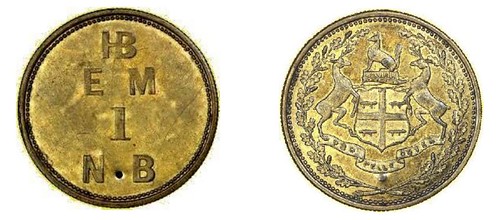
PREV ARTICLE
NEXT ARTICLE
FULL ISSUE
HUDSON'S BAY COMPANY MADE-BEAVER TOKENSThe January 2019 issue of Alaskan Token Collector and Polar Numismatist published by Dick Hanscom includes a short article relating to the Hudson's Bay Company Made-Beaver tokens. It's republished here with permission. Thanks. -Editor H.B.C. "MADE BEAVERS" Below is transcribed a letter that was sold on eBay, from the Hudson's Bay Co. It was an old mimeo (spirit duplicator, blue ink), apparently made in some quantity to answer questions about the tokens. This is probably circa 1940s or 1950s. Parts are illegible.  "The largest of these four brass coins represented one Made-Beaver, the unit of currency used in the fur trade for many decades. It was equal in value to the skin of an adult male beaver in prime condition. The other three represent 1/2, 1/4 and 1/8 made-beaver. "Before these brass tokens came into use, a made-beaver was represented by a stick, a porcupine quill, an ivory disc, a musket ball, or anything else agreed upon between trader and trapper. The trapper would bring his furs to the trading post, and the trader would value them in terms of made-beaver. About 1900, a large beaver skin was worth 12 made-beaver. If the total value of the trapper amounted to 12 made-beaver, the trader would hand him 95 units of the currency agreed upon, and with these he would make his purchases from the trading post. In 1742(?), a beaver would buy 3/4(?) lb. coloured beads, 11/2 lbs. powder, 5 lbs. shot, 8 knives, 1/2 yd. broadcloth, ? lbs. tobacco, and so forth; while guns with a 4 foot barrel would cost 12 made-beavers. "The coins were designed by George Simpson McTavish of Albany Fort in 1854. The design was sent London with the letters MB joined as the HB, thus MB (ed note: showing the letters joined together on the flat edges). but the die cutter interpreted the monogram as the letters N B joined by mistake, so N B went on the coins. E M stands for East Main, the district on the East Mainland of Hudson Bay. "The tokens were still in use in some districts as late a 1910, when they were valued at about fifty cents. The North West Company also employed a beaver token, specimens of which are now very rare." Wayne Homren, Editor The Numismatic Bibliomania Society is a non-profit organization promoting numismatic literature. See our web site at coinbooks.org. To submit items for publication in The E-Sylum, write to the Editor at this address: whomren@gmail.com To subscribe go to: https://my.binhost.com/lists/listinfo/esylum All Rights Reserved. NBS Home Page Contact the NBS webmaster 
|